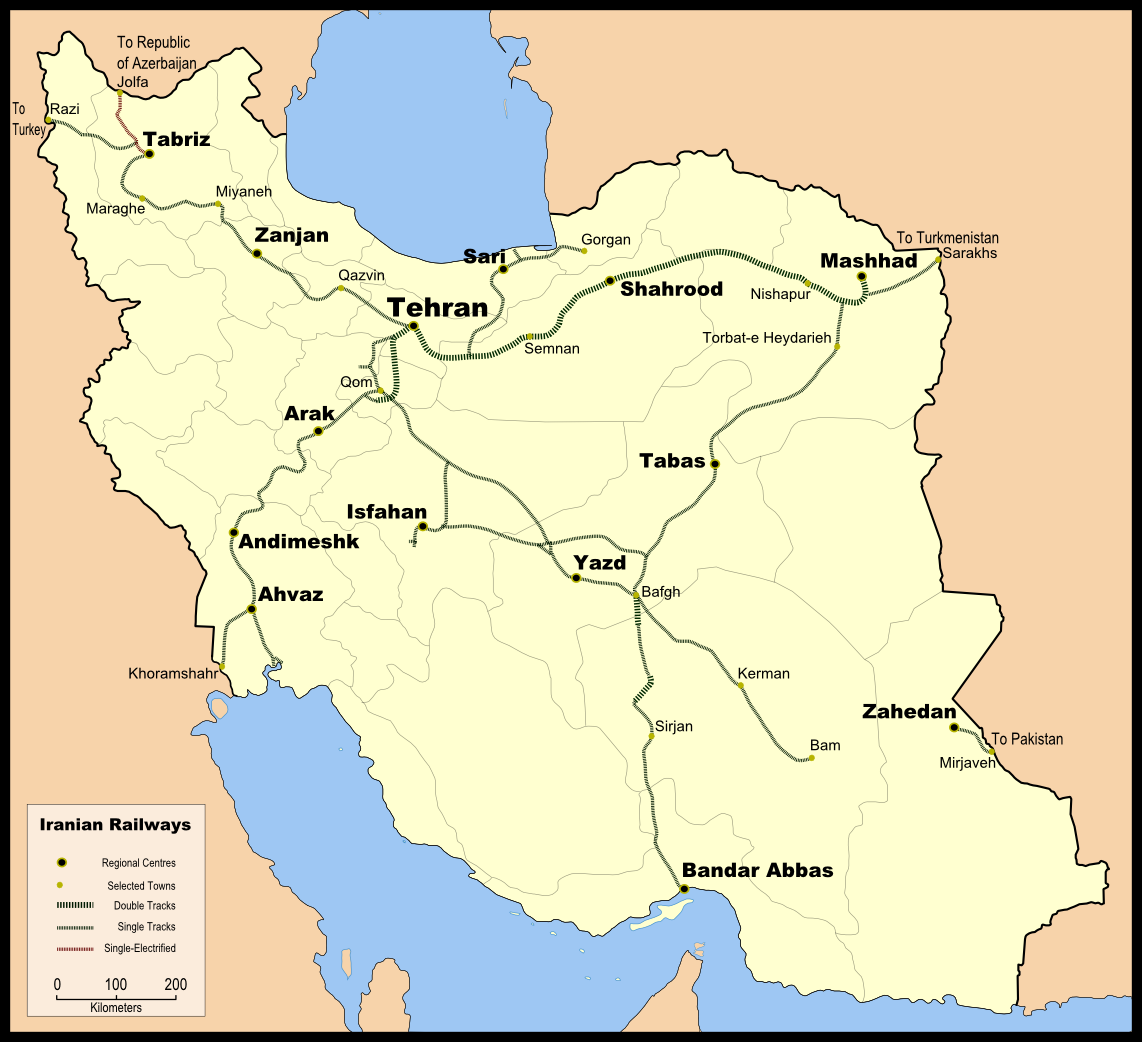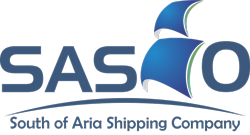Overview of Iran’s Railway Transport System
Iran's railway network, spanning about 14,000 km, plays a pivotal role in international freight by linking domestic ports (e.g., Bandar Abbas) to landlocked neighbors and major corridors. Freight accounts for around 33 million tonnes annually, or 9% of Iran's total transport, with private companies involved in logistics but state-owned IRIR controlling infrastructure. Key corridors like the INSTC reduce costs by 30% and times by half compared to sea routes, integrating rail with road and ship for multimodal efficiency (lca.logcluster & x.com)
Recent launches, such as the China-Iran freight train in 2025, enable oil exports from Iran and machinery imports from China, bypassing U.S. naval influence.
The emphasis on freight railways stems from Iran's geographic advantage, linking landlocked Central Asian nations to Persian Gulf ports like Bandar Abbas and Bandar Imam Khomeini. These routes integrate with global initiatives such as China's Belt and Road Initiative (BRI) and the International North-South Transport Corridor (INSTC), a 7,200 km multimodal network involving ship, rail, and road for cargo between India, Iran, Azerbaijan, Russia, Central Asia, and Europe. The North-South Corridor, with 13 member states, slashes transit times by half and costs by 30% compared to the Suez Canal, enhancing regional security and economic growth through Iran's southern ports (Impriindia & Maritimeducation)

Key Railway Corridors and Transit Routes
Iran’s railway corridors play a crucial role in international freight transport, linking the country with neighboring nations and integrating it into major global networks such as the INSTC and the Silk Road. The key rail routes include:
1.The Iran-Turkey corridor
The Iran-Turkey corridor connects Tehran to Europe through a combination of rail and ferry links. Freight travels from Tehran via Tabriz to the Razi-Kapıköy border, running on standard gauge tracks. At Razi, wagons cross into Turkey and proceed to Van, where a 90-kilometer train ferry across Lake Van at 1,650 meters above sea level carries cargo to Tatvan, integrating with Turkey’s rail network. From there, the corridor extends toward Europe, forming a key segment of the Istanbul-Almaty route. The route handles a diverse range of goods, including packaged foods, electronics, textiles, and up to 19,000 tons of steel annually. Its design capacity aims for one million tonnes via Razi, and regular freight runs reach Germany. The corridor has seen continuous developments, notably the 2017 Iran-Turkey agreement for infrastructure enhancements. By linking east and west overland, this corridor offers a reliable alternative that bypasses congested maritime chokepoints, enhancing regional connectivity and trade efficiency (letsgoiran & trendsresearch & en.imna)
2.Iran-Azerbaijan Routes
Iran-Azerbaijan routes include the following key border crossings:
- Jolfa Border: The Tabriz-Jolfa line (148 km, electrified) connects to Azerbaijan's Nakhchivan exclave with a bogie-changing station for Russian gauge.
- Astara Border: Part of the INSTC's north-south corridor, this involves Qazvin-Rasht-Anzali-Astara (370 km, under construction). It connects Russia and Azerbaijan to Iran's Persian Gulf ports or India, reducing travel by 30-40%. A 2017 Russia-India vow supports completion, enhancing Iran's transit role.
3.Iran-Turkmenistan Routes
Iran-Turkmenistan routes include the following key border crossings:
- Sarakhs Border: The Mashhad-Sarakhs line (165 km) features a bogie-changing station, linking Turkmenistan, Uzbekistan, and beyond as part of the Silk Road railway. It forms the Almaty-Bandar Abbas corridor (opened 2011), entering at Sarakhs and exiting via Bandar Abbas port. Goods include cement, steel, and industrial equipment, with 2 million tonnes annual potential.
- Incheh Borun Border: This supports the east Caspian branch of the North-South Corridor (launched 2014), connecting Kazakhstan and Turkmenistan to Iran's Gulf ports. It diverts east of the Caspian, forecasting 15 million tonnes by 2022.
These routes provide landlocked Central Asia access to seas, integrating with China-Europe lines avoiding Russia.
4.Iran-Pakistan route
The Iran-Pakistan route connects Zahedan to Quetta, Pakistan, via a 94 km line using Indian gauge. At Zahedan, transshipment is required due to the difference in rail gauges. The Bam-Zahedan extension, 546 km long and completed in 2009, enables container traffic. This route handles occasional container shipments. Together, these lines form part of the Istanbul-Tehran-Islamabad corridor, spanning 6,543 km and capable of completing transit in approximately 10 days.
5.Iran-Afghanistan Route
The Mashhad-Khaf line extends to the Shamtiq/Khaf border, with the Khaf-Herat railway (140 km operational to Rozanak from 2020). It connects to Bandar Abbas and Turkmenistan via Sarakhs, enhancing Afghanistan's mineral exports. Goods include cement and industrial materials.
6.Iran-Iraq Route
The Khorramshahr-Shalamcheh line (16 km, completed 2012) reaches the border, with a 2021 agreement for a ~30 km link to Basra, Iraq. Extensions from Arak-Kermanshah (267 km, 2018) aim for Khosravi border. This strategically connects Iran to the Mediterranean via Iraq and Syria's railways. Goods potential includes oil and bulk commodities. Construction involves Chinese firms, with feasibility for Kermanshah-Baghdad.
7.China-Iran-Europe Corridor
Launched in 2025, this 10,400 km route from Xi'an/Urumqi (China) traverses Kazakhstan, Uzbekistan, Turkmenistan (via Sarakhs/Incheh Borun), entering Iran to Aprin dry port near Tehran. It cuts times to 15 days vs. 30-40 by sea, bypassing U.S. sanctions and bases. Goods include Chinese machinery/electronics and Iranian oil, with extensions to Europe/Iraq/Syria. Under BRI and a $400 billion China-Iran deal (2021), it strengthens ties, with twice-weekly operations initially.
These routes mitigate Iran's logistical isolation, fostering economic ties amid sanctions. The China-Iran link, for instance, enables unhindered oil exports and positions Iran as a Eurasia hub, challenging U.S. hegemony.
Ongoing projects include the $3 billion Tehran-Qom-Isfahan high-speed rail (due 2026) and Basra-Shalamcheh link with Iraq.
Advantages of Rail Freight Transport in Iran
Iran’s rail freight transport plays an essential role in shaping the country’s logistics network and international trade routes. The following are the key benefits of using rail logistics in Iran:
1. Cost Efficiency for Long-Distance Cargo
Rail freight in Iran provides a highly economical option for moving large volumes of goods over long distances. Compared to road transport, railway operations consume less fuel and reduce overall logistics costs, making it a preferred choice for heavy cargo.
2. Reliable Transit Routes for International Trade
Iran’s rail corridors link major ports and border terminals to Central Asia, Turkey, and Europe, creating reliable transit pathways for cross-border trade. This stability ensures consistent delivery schedules and lower risk of delays caused by border congestion.
3. Environmental Sustainability
Rail transport in Iran contributes to greener logistics by significantly reducing CO₂ emissions compared to trucking. The increasing electrification of railway lines further enhances energy efficiency and environmental performance.
4. Increased Cargo Capacity
Iran’s railway system can handle higher freight volumes in a single trip, reducing the number of journeys required for large shipments. This capacity makes rail freight particularly advantageous for industrial exporters and bulk cargo operators.
5. Enhanced Connectivity with Regional Networks
Iran’s rail network is integrated with key international corridors such as the International North–South Transport Corridor (INSTC) and Trans-Asian Railway, offering direct access to Russia, India, Central Asia, and Europe. This connectivity boosts Iran’s role as a vital trade bridge between continents.
6. Secure and Safe Cargo Movement
Rail freight offers higher security for valuable or sensitive goods, minimizing risks of theft, accidents, and damage during transit. Modern monitoring systems on Iran’s major rail routes further ensure cargo safety and tracking accuracy.
7. Governmental Support and Financial Incentives
Since Iran’s railway system is state-owned, companies that use domestic rail transport can benefit from government support and financial incentives. Continuous public investment in the railway sector helps lower transportation costs, improve infrastructure quality, and encourage more businesses to adopt rail-based logistics solutions.
Challenges of Rail Freight Transport in Iran
Despite numerous challenges, Iran’s rail freight transport also faces the following drawbacks and obstacles:
- Aging Infrastructure: Parts of Iran’s railway network are old and require maintenance and upgrades to allow for higher-capacity freight transport.
- Limited Electrification: Most railway lines still operate on diesel. This limitation increases fuel costs and reduces efficiency compared to electric systems.
- Capacity Constraints: High freight volumes on certain main routes sometimes create scheduling and planning bottlenecks.
- Integration with Other Transport Modes: Coordination with road and port transport in some areas needs improvement to ensure smoother and faster cargo transfers.
- Skilled Workforce: Continuous staff training and adoption of modern technologies are necessary to maintain safety and operational efficiency across the railway network.
These challenges also present opportunities for improvement and development. Partnering with the best reliable Iranian freight forwarding company can help overcome many of these issues efficiently.
Required Documents for Rail transit of Goods from Iran
Shipping cargo by rail from Iran to other countries requires specific documents to ensure smooth and timely transport. Essential documents include:
- Commercial Invoice: Details of goods, quantity, weight, value, seller and buyer information, payment method, and shipping method.
- Transit Insurance Certificate: Covers domestic or international transit, protecting cargo during transport.
- Customs Clearance Permit (Bijak): Official approval for cargo shipment recognized by customs authorities.
- Permits from Relevant Authorities: Depending on the type of goods, e.g., agricultural products, livestock, or medical items.
- Health Certificate: Required for perishable goods like food, fruits, vegetables, meat, or pharmaceuticals.
Completing these documents accurately is crucial. Partnering with a professional rail freight company helps ensure all paperwork is in order, minimizing delays and risks during international transport.

Which Goods Are Suitable for Iran’s Railway Transport?
Iran’s railway transport network is one of the most strategic freight systems in the Middle East, connecting the Persian Gulf to Central Asia, Turkey, and the Caucasus. The system is best suited for bulk, heavy, and non-perishable goods that benefit from cost efficiency and stability over speed.
1. Minerals and Mining Products
Mining materials such as iron ore, copper, and industrial minerals account for nearly half of Iran’s total rail cargo volume, according to the Islamic Republic of Iran Railways (RAI). These commodities are ideal for trains due to their heavy weight and low value-to-weight ratio (mehrnews.com)
2. Bulk Agricultural and Industrial Goods
Cement, grain, coal, fertilizers, and animal feed are regularly shipped across the country using Iran’s rail freight system. The ability to move thousands of tons in a single trip makes rail far more economical than trucks.
3. Containers and Transit Freight
Iran’s position as a regional transit corridor enables efficient movement of containerized goods between Asia, Europe, and the CIS region. The country’s growing container rail links — especially on the International North-South Transport Corridor — support both import and export operations.
4. Construction Materials and Fuel Products
Materials like steel bars, ceramics, and bitumen are frequently moved by rail using open or tank wagons. Though tank capacity is limited, government investments in rail infrastructure aim to expand this segment.
Types of Cargo Unsuitable for Iran’s Railway Transport Network
Despite its strengths, the Iranian railway system is not suitable for perishable goods that require cold-chain logistics, since refrigerated wagons are scarce. Likewise, small parcels, single vehicles, or commercial samples are better handled by air transport or road. Hazardous and restricted goods may also face regulatory limitations, making road freight a safer alternative.
Experience Seamless Rail Freight with SASCO
Streamline your cargo transport by rail with SASCO. From efficient scheduling to secure handling, SASCO ensures your goods move smoothly across borders, reducing transit time and simplifying logistics. Discover a reliable, professional, and cost-effective rail freight experience tailored for your business needs.







